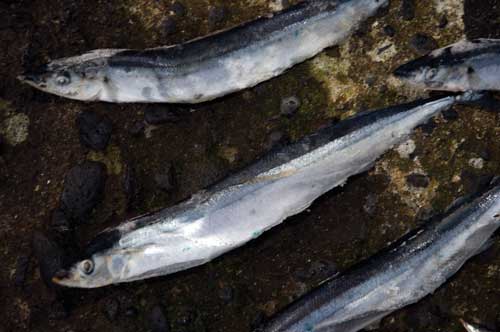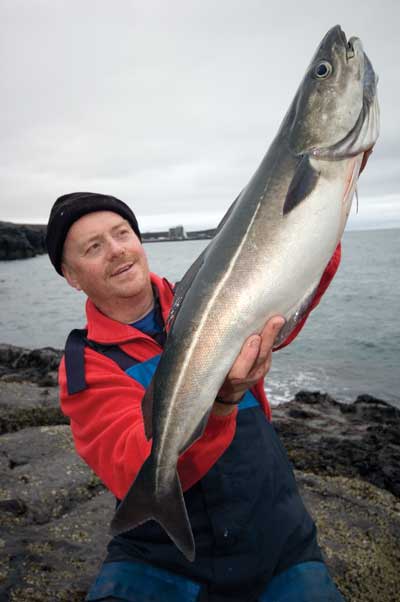There’s a new fish bait on the market that’s going to establish itself as a direct competitor to mackerel.
I first came across the “Bluey” when fishing in Iceland during the summer of 2006. Geordie angler Steve Mason, a professional fish filleter now living and working in Iceland, came across these saury type fish being brought in to Iceland from the Far East as commercial bait. Realising its potential, he tried it for shore angling and found it just as effective as normal lugworm, mussel and squid baits for the local cod, haddock, catfish and many other species. So much so, that he now rarely digs worms or collects shellfish relying heavily on the bluey’s.
Returning to Iceland in April 2007, I fished exclusively with bluey baits recording cod to double figures, haddock, catfish, lemon sole, dabs, whiting, and a personal best shore coalie of close to 6lbs.

So what is a bluey! It looks a little like a short beaked garfish in body shape, and is not dissimilar to the ballyhoo baitfish used extensively in the Florida Keys and along the southern east coast of America. They average about 12-inches in length.
The key to the success of this new bait is its oil content. Mackerel strips or chunks tend to wash out within 15 minutes or so in a good tide run. The advantage of the bluey is that it carries a much higher volume of oil. Although you still get the sudden explosion of oil as the bait hits the seabed, the higher volume of oil and its denser viscosity holds better in the flesh and washes out far slower meaning the bait remains more effective for much longer than mackerel will when using equal size baits.
Paul Bird who runs the Bait Box bait company also realised the potential of the bluey and is now importing this revolutionary bait here in to the UK. The pike boys have already seized upon the bluey and in initial testing it’s proved a killer bait for pike of all sizes, also catfish and big eels.

In early sea trials we’ve found the bluey at least equal, to and in many cases, a superior bait to both frozen and fresh mackerel when using the two baits along side each other. This is from both boat and shore when fishing for tope, huss, rays and conger. It’s also proved effective as strip baits for dabs, gurnards, bream and whiting.
It has another advantage too…its body shape. Being cylindrical in shape like a garfish, you can cut straight through the body to create a fat but streamlined bait which is easy to present on the hook and is streamlined for long range casting, be it uptiding off the boat or when shore fishing. Even the full length body with the head and tail cut off to create a really big bait will cast a long way, plus it’s an easy shape for big predators to take whole.
If you’re after huss, strap conger and rays, then look to cut a section of body off about 3-inches long. For tope I double the length to 6-inches for both shore and boat fishing. I’m also expecting half body length baits of bluey to prove a killer for specimen bass this coming autumn.
I first came across the “Bluey” when fishing in Iceland during the summer of 2006. Geordie angler Steve Mason, a professional fish filleter now living and working in Iceland, came across these saury type fish being brought in to Iceland from the Far East as commercial bait. Realising its potential, he tried it for shore angling and found it just as effective as normal lugworm, mussel and squid baits for the local cod, haddock, catfish and many other species. So much so, that he now rarely digs worms or collects shellfish relying heavily on the bluey’s.
Returning to Iceland in April 2007, I fished exclusively with bluey baits recording cod to double figures, haddock, catfish, lemon sole, dabs, whiting, and a personal best shore coalie of close to 6lbs.

So what is a bluey! It looks a little like a short beaked garfish in body shape, and is not dissimilar to the ballyhoo baitfish used extensively in the Florida Keys and along the southern east coast of America. They average about 12-inches in length.
The key to the success of this new bait is its oil content. Mackerel strips or chunks tend to wash out within 15 minutes or so in a good tide run. The advantage of the bluey is that it carries a much higher volume of oil. Although you still get the sudden explosion of oil as the bait hits the seabed, the higher volume of oil and its denser viscosity holds better in the flesh and washes out far slower meaning the bait remains more effective for much longer than mackerel will when using equal size baits.
Paul Bird who runs the Bait Box bait company also realised the potential of the bluey and is now importing this revolutionary bait here in to the UK. The pike boys have already seized upon the bluey and in initial testing it’s proved a killer bait for pike of all sizes, also catfish and big eels.

In early sea trials we’ve found the bluey at least equal, to and in many cases, a superior bait to both frozen and fresh mackerel when using the two baits along side each other. This is from both boat and shore when fishing for tope, huss, rays and conger. It’s also proved effective as strip baits for dabs, gurnards, bream and whiting.
It has another advantage too…its body shape. Being cylindrical in shape like a garfish, you can cut straight through the body to create a fat but streamlined bait which is easy to present on the hook and is streamlined for long range casting, be it uptiding off the boat or when shore fishing. Even the full length body with the head and tail cut off to create a really big bait will cast a long way, plus it’s an easy shape for big predators to take whole.
If you’re after huss, strap conger and rays, then look to cut a section of body off about 3-inches long. For tope I double the length to 6-inches for both shore and boat fishing. I’m also expecting half body length baits of bluey to prove a killer for specimen bass this coming autumn.

